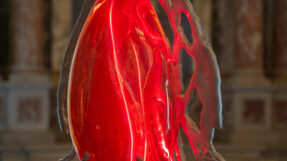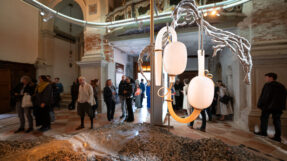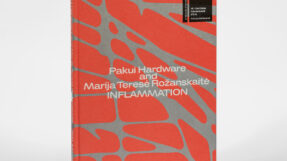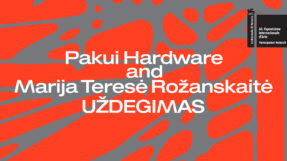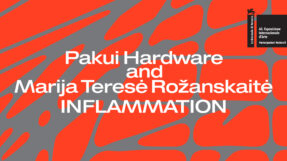Lithuanian national pavilion: international recognition, thousands of visitors and the selling-out catalogue
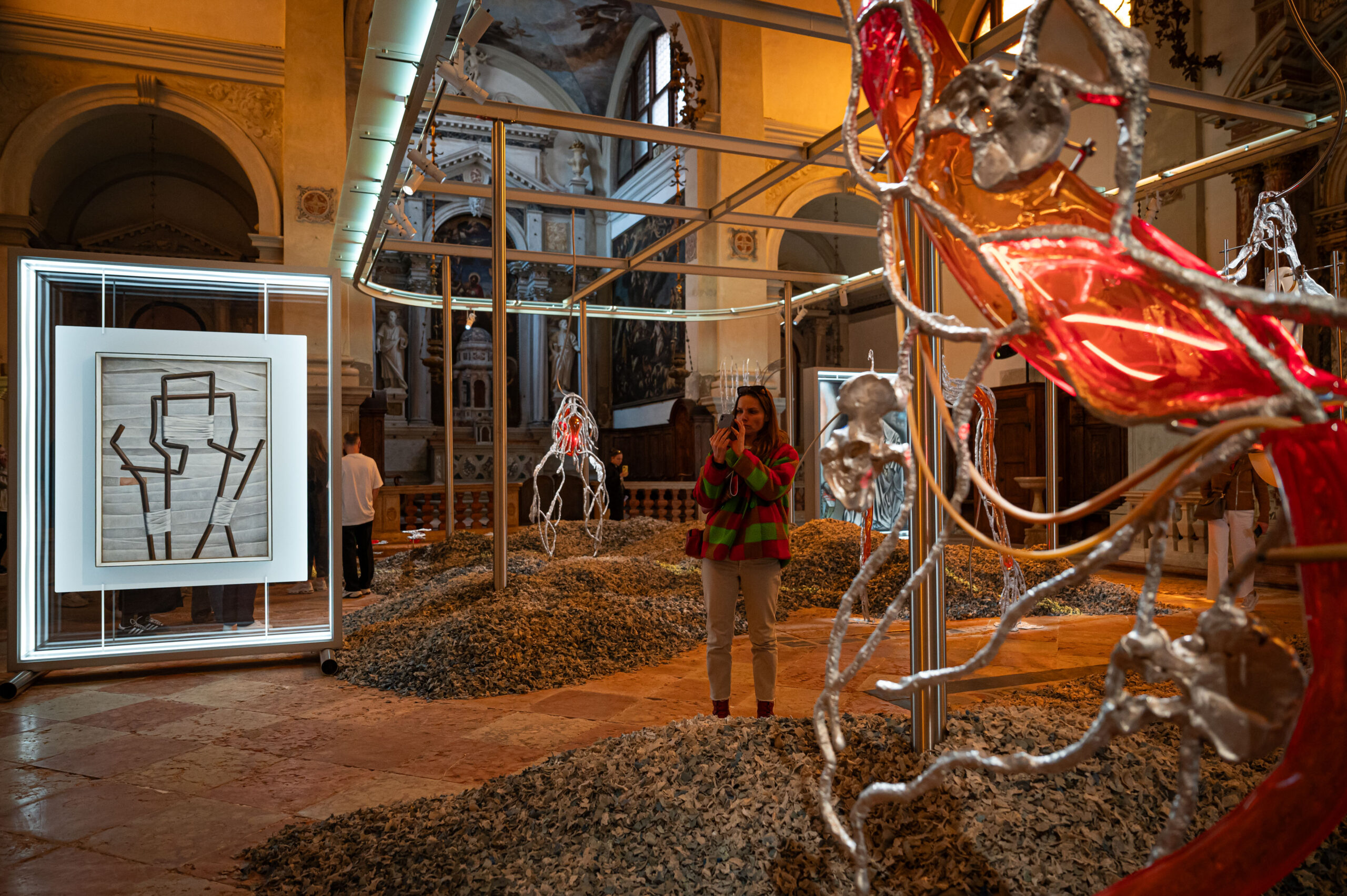
The Lithuanian national pavilion featuring an exhibition Inflammation by Pakui Hardware – the artist duo of Neringa Černiauskaitė and Ugnius Gelguda – and Marija Teresė Rožanskaitė (1933 – 2007) has been opened at the Venice Contemporary Art Biennale. On the eve of the opening, the influential cultural news platforms have included the pavilion curated by Valentinas Klimašauskas and Joa Laia into recommended top lists. During the first days of the biennial, the Inflammation has been visited by over ten thousand people.
Commissioner of the pavilion is Dr Arūnas Gelūnas, Director General of the LNMA. The scenery and architecture of the installation are designed by Petras Išora-Lozuraitis ir Ona Lozuraitytė-Išorė (Išora x Lozutaitytė Studio). The Lithuanian national pavilion at Sant‘Antonin Church will be open until 31 October.
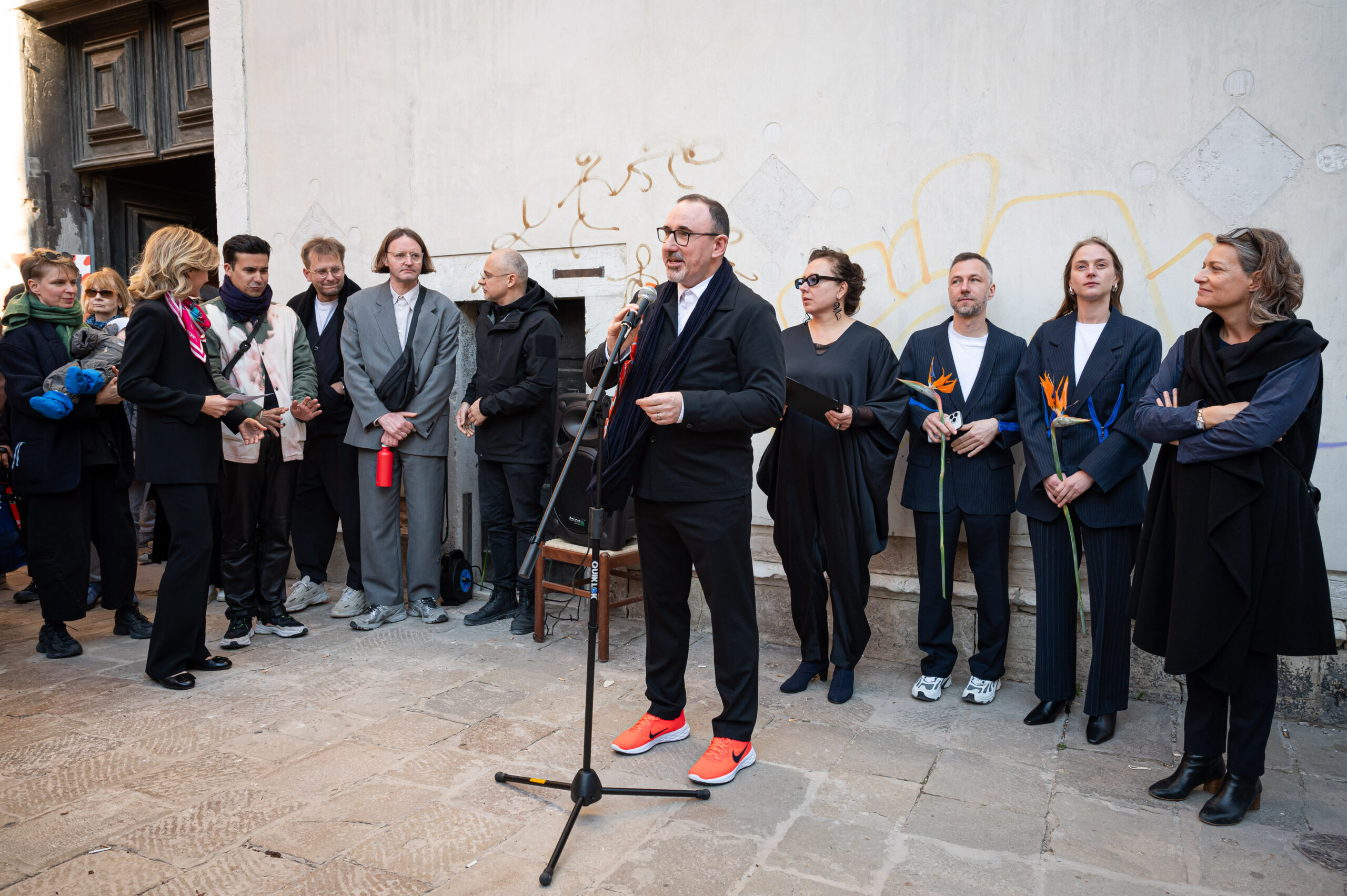
The opening event attracted flocks of fans
The official opening of the Inflammation by Pakui Hardware and Marija Teresė Rožanskaitė took place on 19 April. On Friday night Sant’Antonin Church, the site of the pavilion attracted plenty of art pilgrims, fans of the Lithuanian art and Lithuanian artists, and Venetians. The guests filled up the square before the church, others observed the event from the neighbouring bridge and even from the opposite side of the canal.
During the opening, the artists, the curators and the entire creative team were congratulated by Daina Urbanavičienė, Vice Minister of Culture of the Republic of Lithuania, and Dalia Kreivienė, Ambassador of the Republic of Lithuania in Italy.
“Participation at the Venice Biennale for a every artist is, in a sense, a chronic inflammation. It opens up new opportunities, even though it requires a lot of energy and stamina. I am positive that for the Lithuanian duo Pakui Hardware it will also be the beginning of something new, great and exciting. I am also very happy that the art by Marija Teresė Rožanskaitė is presented in Venice. She was a grand Lithuanian artist, whose life, unfortunately, was very hard due to political circumstance. We can also say that her life was plagued by multiple inflammations. But today she is here, just like Pakui Hardware, celebrating another victory of culture and creation,” Urbanavičienė, vice minister of culture, said.
The Ambassador Kreivienė has complimented the Lithuanian artists and their entire creative team, who came to realize one of the most beautiful pavilions of the Venice Biennale, a top-notch act of representing the culture and art of Lithuania. Each visitor to the exhibition, she has said, is sure to find an inclusive and a rich-contemplation-evoking installation that bridges the visions by two Lithuanian artist generations, whose artwork is a child of very different contexts. Yet here it is seamlessly integrated into the beautiful space of the Chiesa di Sant’Antonin.
Commissioner of the pavilion and director general of the LNMA, Dr Gelūnas has noted that the Lithuanian national pavilion is another testimony how art brakes all barriers, the Inflammation by Pakui Hardware and Marija Teresė Rožanskaitė has been very successful at that.
Present at the opening Agnès Alfandari, director of the Mobilities and International Events Department of the Institut Français in Paris, has pointed out in her welcoming speech how the art of Pakui Hardware and M.T. Rožanskaitė link the Lithuanian national pavilion and the programme of the Lithuanian Season in France.
The opening event was attended by the Lithuanian Ambassador at the Holy See Sigita Maslauskaitė-Mažylienė, Lithuanian Honory Consul in Padua Alberto Francheschi, Lithuanian Cultural Attache in Italy Laura Gabrielaitytė-Kazulėnienė, Director of the Lithuanian Culture Institute Julija Reklaitė, Commissioner of Lithuanian Season in France Virginija Vitkienė, by the representatives of Marija Teresė Rožanskaitė’s family, by art critics, curators, reporters, and the representatives of the partners and supporters. The gathering took no haste to disperse, admiring the pavilion lit up by the evening sun, socializing and discussing the exhibition even in the afterhours of the exhibition.
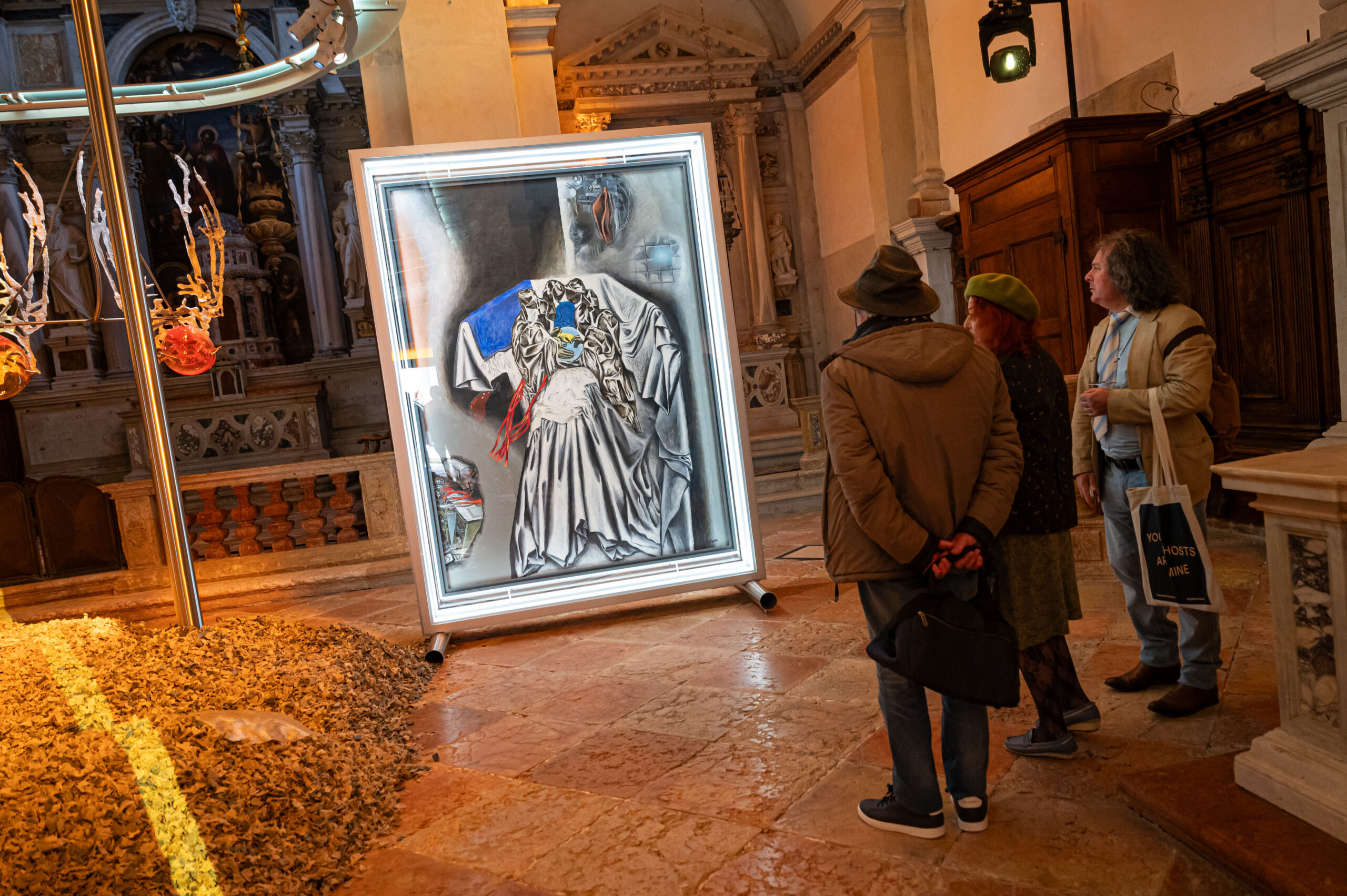
Aesthetically and intellectually captivating inflammation
The international cultural media lionize the Lithuanian Pavilion curated by Valentinas Klimašauskas and Joao Laia. The senior editor of the influential ARTnews.com Alex Greenberg included the Inflammation into top 10 national pavilions. No 5, the Lithuanian pavilion, is described as “the most beautifully installed” “a body horror extravaganza set within a 17th-century church”.
The German cultural news giant Monopol went even further. Their list of the most worth-while pavilions places the Lithuanian pavilion at the very top, before the German, French, the United States, and other pavilions. The article thus describes the charmful installation in the church: “Pakui Hardware show spider-like, pulsating sculptures made of aluminium and glass, half organic, half technological, similar to the motifs in the paintings of Rožanskaitė, who died in 2007. It’s about medicine, the body, the inflammation sweeping the planet – all in a space of enlightenment.”
Inflammation received international media attention already in its preview stage. Interviews with the artists and reviews were carried by Artform, ArtReview, Kunstforum International, and other.
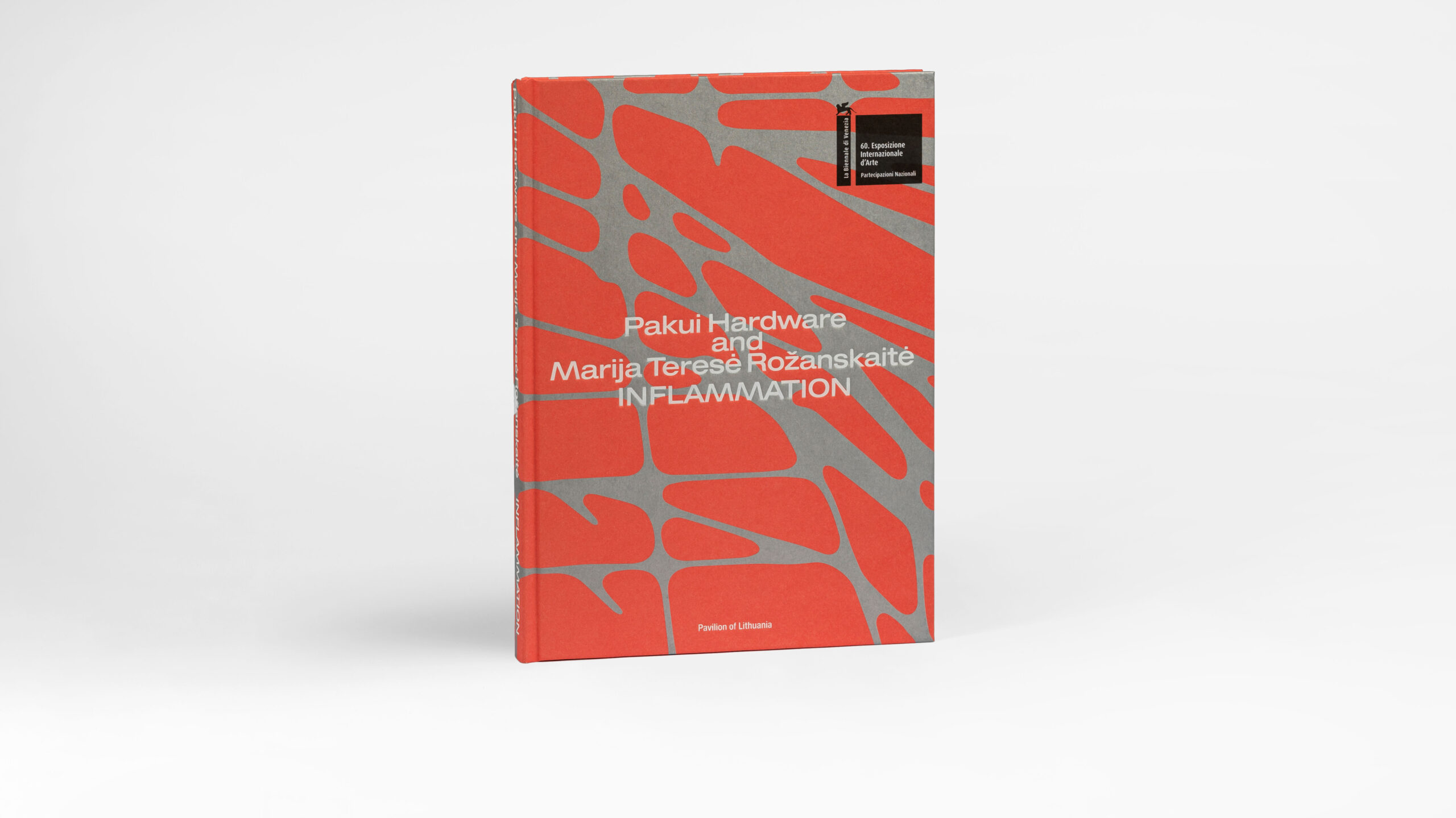
The catalogue of the pavilion is about to sell out, a new book about M.T. Rožanskaitė also receives its fans
The catalogue of the exhibition published by the LNMA and the Mouse Publishing is about to sell out. The scarlet cover with silver nerve threads catches the attention of buyers at the pavilion and the Venice Biennale. The catalogue compiled by Pakui Hardware, Klimašauskas, Laia, Egla Mikalajūnė carries texts by Gelūnas, Estelle Hoy, Lozuraitytė-Išorė and Petras Išora-Lozuraitis, Klimašauskas, Laia, Inga Lācė. The catalogue includes high quality reproductions of the works by Pakui Hardware and M.T. Rožanskaitė.
A very recent catalogue Marija Teresė Rožanskaitė: X-Rays of Art and Life presented at the Lithuanian national pavilion also receives attention. The compilers of the publication by MRT Art Foundation are Dr Laima Kreivytė and Marius Piekuras. At 6 pm Tuesday 7 May they will present the book in Vilnius, at Vytautas Kasiulis Art Museum of the LNMA.
A take by different generations on the effects of systemic harm and the invitation to heal
Inflammation opened in Venice brings together the practice and experience of different generations and explores the inflammatory effects of current economic and social conditions on (post)human, social and planetary bodies. The paintings by M.T. Rožanskaitė and the installation of sculptures are connected by the themes of medicine and health, nature, Cosmos and the motifs of industrial landscape.
“Inflammation allows one to perceive what is not seen by the naked eye: history inscribed in human and planetary bodies, systems that are the real root of malady, suppressed internal burning. Yet, once recognized, this can be a starting point on the way to convalescence—if only we could start taking the interconnectedness of things, living and inanimate alike, into more serious consideration. The installation invites the viewer to enter a certain state of mind and body, perhaps a little feverish and dizzy, in order to feel the web of life, which consists of a multitude of entities and fields, from medicine to hybrid nature, and from nervous systems to fractured sounds of technological scanning,” the artists Černiauskaitė and Gelguda say in their statement.
Foreigners Everywhere/Stranieri Ovunque
The Venice Biennale is held every two years since 1895. It is the most prestigious exhibition of contemporary art worldwide. The theme of this year’s edition is Foreigners Everywhere/Stranieri Ovunque. Curator Adriano Pedrosa decided that the jubilee edition should give centre stage to the artists who actually are foreigners – immigrants, exiles, diaspora, emigrants, deportees and refugees.
National Pavilion of Lithuania
60th International Contemporary Art Exhibition – La Biennale di Venezia
Chiesa di Sant’Antonin
Castello 3300
30122 Venice
https://www.labiennale.org/en/noticeboard/453
Open I–VII, 11 am to 7 pm
Access from vaporetto station San Zaccaria A.
Organiser: The Lithuanian National Museum of Art
Artists: Pakui Hardware (Neringa Černiauskaitė, Ugnius Gelguda) and Marija Teresė Rožanskaitė
Curators of the pavilion: Valentinas Klimašauskas, Joao Laia
Commissioner of the pavilion: Arūnas Gelūnas
Exhibition environment and landscape architects: Išora x Lozuraitytė Studio (Petras Išora-Lozuraitis and Ona Lozuraitytė-Išorė)
Light artist: Eugenijus Sabaliauskas
Designer: Vytautas Volbekas
Coordinators: Evaldas Stankevičius, Egla Mikalajūnė
Architect coordinator: Eglė Jagminė
Public relations producer: Rūta Statulevičiūtė-Kaučikienė
Translator of texts into Italian: Adriano Cerri
English text editor: Alexandra Bondarev
Presented by: Ministry of Culture of the Republic of Lithuania
Financed by: Lithuanian Council for Culture
Partners:
carlier | gebauer
Plasta Group
Sponsors:
Exterus
International COBALT
Girteka
Glassic
Linen Tales
Noewe Foundation
Nord Cranes Systems
Piritas
Special thanks by the LNMA to: Algė Andriulytė, Micola Clara Brambilla, Laura Gabrielaitytė-Kazulėnienė, Norbert Hinc, Andrius Ivanovas, Lolita Jablonskienė, Milvydas Kezys, Povilas Laurinaitis, Simonas Mackevičius, Aušrinė Mačėnienė, Jolanta Marcišauskytė-Jurašienė, Gediminas Mikelaitis, Mindaugas Reklaitis, Arūnas Steponėnas, Marco Scurati, Mažvydas Truklickas, Jonas Volosčenka.

